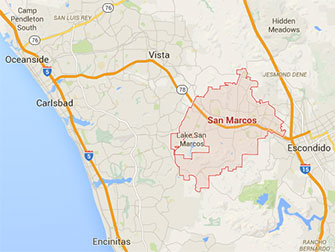San Marcos is located in the North County region of San Diego County, split in half by State Route 78 and just West of Interstate 15. Cities that border San Marcos include Escondido to the east, Carlsbad to the west, Vista to the northwest and Encinitas to the southwest. San Marcos is considered the Education Hub of North County, hosting schools such as Cal State San Marcos, Palomar College, University of St. Augustine and top ranked public High Schools.
 San Marcos is host to several award winning microbreweries along the 78 ‘Hops Highway’, such as the Lost Abbey, Rip Current Brewing, Dos Desperados Brewery and more. San Marcos is known for it’s natural beauty, iconic ridgelines and outdoor recreation (parks and trails). Other major attractions include Old California Restaurant Row, and the Edwards San Marcos 18.
San Marcos is host to several award winning microbreweries along the 78 ‘Hops Highway’, such as the Lost Abbey, Rip Current Brewing, Dos Desperados Brewery and more. San Marcos is known for it’s natural beauty, iconic ridgelines and outdoor recreation (parks and trails). Other major attractions include Old California Restaurant Row, and the Edwards San Marcos 18.
San Marcos Population
The population of San Marcos in 2013 was 89,387.
View the population of San Marcos compared to nearby cities along State Route 78.
San Marcos Demographics
The 2010 estimates for San Marcos race demographic was:
WHITE: 49%
HISPANIC: 37%
ASIAN: 9%
TWO OR MORE RACES: 3%
BLACK: 2%
AMERICAN INDIAN: <1%
For more San Marcos demographic information, visit SANDAG
San Marcos History
For more information about San Marcos History, visit the San Marcos Historical Society at San Marcos Heritage Park (part of Walnut Grove Park).
From Wikipedia:
According to historical legends, the San Luis Rey Mission flocks were robbed by a small band of Native Americans in the late 18th century. Fleeing the Spanish troops, the Native Americans escaped to the hills. While pursuing the Native Americans, the Spaniards came upon a fertile valley in 1797 which was named Los Vallecitos de San Marcos (Little Valleys of Saint Mark) to honor the day of discovery: April 25, St. Mark’s Day. On April 22, 1840, Governor Juan B. Alvarado granted Rancho Vallecitos de San Marcos to his relative, Jose María Alvarado. Jose Alvarado was killed at the Pauma Massacre in 1846, and the land was left to his wife; she then sold the land to Lorenzo Soto. In the late 1850s, Soto sold part of his land to Cave Couts and his family was soon raising livestock. Although Cave Couts owned the land, Major Gustavus French Merriam from Topeka, Kansas made the first permanent settlement. Merriam homesteaded 160 acres (0.65 km2) in the north Twin Oaks Valley and began wine and honey production.
After Major Merriam’s settlement, German and Dutch immigrants began moving into the area in the early 1880s. Then in 1883 a few miles south of the settlement, John H. Barham founded the first town in the area. By 1884, the town of Barham had a post office, blacksmith, feed store and a weekly newspaper. In 1887, the San Marcos Land Company bought almost all of the San Marcos land formerly owned by the Couts family and promptly divided the land into tracts. Soon the beautiful hills began attracting home-seekers.
The original town of San Marcos was at the intersection of what is now Grand Avenue and Rancho Santa Fe Road. In 1887, the Santa Fe Railroad announced that it was going to lay tracks going through the valley, but to the disappointment of the citizens, the tracks were laid one mile (1.6 km) away from the center of the town. By 1896, San Marcos was a community with its own stores, post office, blacksmith and railroad depot. In 1903, the town appeared to be going downhill, so the people of San Marcos picked up their homes and moved along the railroad tracks to what now are Mission Road and Pico Avenue. By 1905, the town had every convenience, including rural mail delivery and telephone service. The first school in the area, which had started in Barham in 1880, was moved in 1889 to San Marcos. Later that same year, the Richland School was built, being the second school in San Marcos. The main business in San Marcos in the 19th and early 20th centuries was farming. In the mid-20th century, dairies and poultry production became a big part of the business in the town.
San Marcos experienced a period of growth from 1956 onward, when the first water from the Colorado River arrived. Several small businesses were founded and the population rapidly increased to 2,500. San Marcos became an incorporated city on January 28, 1963. In the 1970s, San Marcos was flourishing as the third fastest-growing city in the state with a population of 17,479 by 1980. The population continued to boom over the next two decades, reaching 33,800 in 1990 and 82,743 in 2000.

